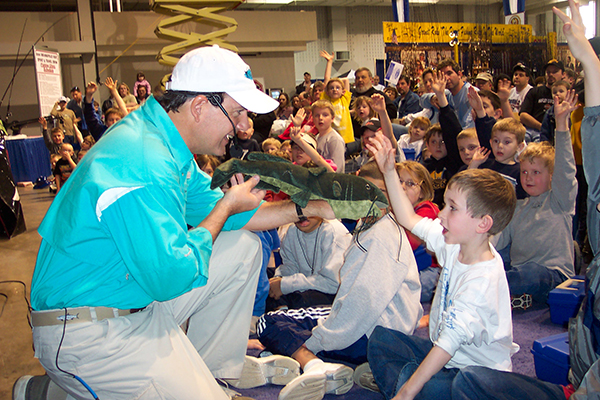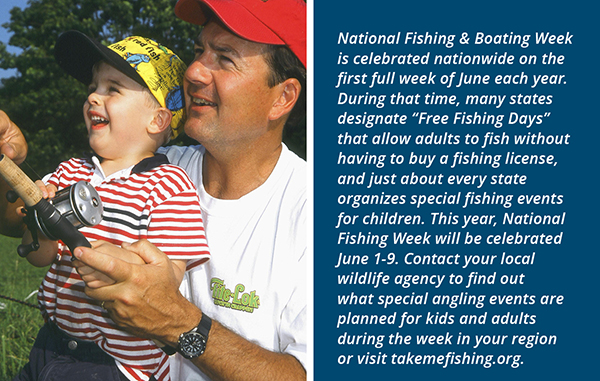Chances are, like most anglers today, you were first introduced to fishing by the time you reached age 12 and learned the skills from an adult family member. That’s what the most recent angling interest studies reveal, anyway. As a professional educator, author, angler and dad who conducts kids fishing clinics at sport shows across the nation, I can vouch for those findings. And as one who has taught his fair share of youngsters to fish, here are my Top Ten Tips to keep mind when you have the opportunity to introduce a child – of any age – to angling:

Tip #1: Start the fishing lesson at home, even days prior to the trip, by visiting a local tackle store with the child, allowing the youngster to be a part of the entire process of selecting tackle and asking around about a good place to go fishing. A visit to the local library to check out books on fishing is a good way to begin the process as well.
Tip #2: Practice casting, knot tying and bobber-setting at home or at the local park, where errant casts can’t catch in overhead trees or stream-side brush and knots and bobbers can be figured out away from the excitement of catching a fish.
Tip #3: Keep the child’s fishing equipment simple. A cane pole is a great first fishing rod, especially for younger anglers. Simple spin-casting tackle, such as the special youth models now offered by several tackle manufacturers, are good choices as well. Allow the child to have his or her own tackle box, in which to store hooks, bobbers and sinkers.
Tip # 4: Consider trading in your fishing tackle for a camera for the day. By leaving your tackle at home, you are more likely to stay involved in the child’s activities -- and less tempted to get caught up in the catching yourself in the event the fishing gets fast! With a camera, you can record the day’s activities, including that most momentous of events: a child’s first fish.

Tip #5: Select a place to fish from shore that offers an abundance of easily caught panfish, such as bluegill, crappie or perch. Docks or piers are excellent places to start, because they are clear of trees and other obstacles that snag casts, and provide cover below the water for fish. Open shoreline areas along ponds, lakes and slow-moving streams can be good too. Boats can be used, but keep in mind that kids need “elbow room” when fishing, and often feel confined when having to stay aboard a boat for any length of time.
Tip #6: Use live bait. Nothing catches panfish more consistently that live bait such as worms, nightcrawlers, crickets or minnows, and a primary goal of these first fishing trips is to catch fish in order to maintain a child’s interest in the activity. Live bait is also interesting for the child to touch and play with, which he or she should be allowed to do when the fishing gets slow or the youngster simply wants to do something else for a while.
Tip #7: Use a bobber. Nothing is as fascinating to a child as a bobber dancing on the surface, especially when the child knows what’s causing it! The bobber also provides some casting weight, allows the child to see as well as feel strikes, and keeps the bait up off the bottom in front of the fish and away from underwater snags.
Top #8: Take plenty of snacks and drinks, different kinds of bait for variety, and make sure you’ve got raingear, jackets to match the weather, and insect repellant and sunscreen if needed. You want the child to be as comfortable as possible during the fishing session.
Tip #9: Keep the first sessions short. When the child says it’s time to go home -- go! You want these first trips to be remembered as something fun, and when the fun ends for a child, it’s time to end the fishing trip, no matter how well the fish are biting or how early in the trip it might be.
Tip #10: Talk to the child during the fishing trip. Talk about anything, remembering that these are important times for youngsters, who value their time with you (whether they show it or not) and are perfect times to share feelings about anything under the sun. You can discuss angling topics like conservation, fishing tactics, what makes a bobber work or social subjects like what it takes to do well in school. The sky is the limit to the conversations – and fun – you can enjoy while teaching a kid to fish!
Back to Blue Life

Tip #1: Start the fishing lesson at home, even days prior to the trip, by visiting a local tackle store with the child, allowing the youngster to be a part of the entire process of selecting tackle and asking around about a good place to go fishing. A visit to the local library to check out books on fishing is a good way to begin the process as well.
Tip #2: Practice casting, knot tying and bobber-setting at home or at the local park, where errant casts can’t catch in overhead trees or stream-side brush and knots and bobbers can be figured out away from the excitement of catching a fish.
Tip #3: Keep the child’s fishing equipment simple. A cane pole is a great first fishing rod, especially for younger anglers. Simple spin-casting tackle, such as the special youth models now offered by several tackle manufacturers, are good choices as well. Allow the child to have his or her own tackle box, in which to store hooks, bobbers and sinkers.
Tip # 4: Consider trading in your fishing tackle for a camera for the day. By leaving your tackle at home, you are more likely to stay involved in the child’s activities -- and less tempted to get caught up in the catching yourself in the event the fishing gets fast! With a camera, you can record the day’s activities, including that most momentous of events: a child’s first fish.

Tip #5: Select a place to fish from shore that offers an abundance of easily caught panfish, such as bluegill, crappie or perch. Docks or piers are excellent places to start, because they are clear of trees and other obstacles that snag casts, and provide cover below the water for fish. Open shoreline areas along ponds, lakes and slow-moving streams can be good too. Boats can be used, but keep in mind that kids need “elbow room” when fishing, and often feel confined when having to stay aboard a boat for any length of time.
Tip #6: Use live bait. Nothing catches panfish more consistently that live bait such as worms, nightcrawlers, crickets or minnows, and a primary goal of these first fishing trips is to catch fish in order to maintain a child’s interest in the activity. Live bait is also interesting for the child to touch and play with, which he or she should be allowed to do when the fishing gets slow or the youngster simply wants to do something else for a while.
Tip #7: Use a bobber. Nothing is as fascinating to a child as a bobber dancing on the surface, especially when the child knows what’s causing it! The bobber also provides some casting weight, allows the child to see as well as feel strikes, and keeps the bait up off the bottom in front of the fish and away from underwater snags.
Top #8: Take plenty of snacks and drinks, different kinds of bait for variety, and make sure you’ve got raingear, jackets to match the weather, and insect repellant and sunscreen if needed. You want the child to be as comfortable as possible during the fishing session.
Tip #9: Keep the first sessions short. When the child says it’s time to go home -- go! You want these first trips to be remembered as something fun, and when the fun ends for a child, it’s time to end the fishing trip, no matter how well the fish are biting or how early in the trip it might be.
Tip #10: Talk to the child during the fishing trip. Talk about anything, remembering that these are important times for youngsters, who value their time with you (whether they show it or not) and are perfect times to share feelings about anything under the sun. You can discuss angling topics like conservation, fishing tactics, what makes a bobber work or social subjects like what it takes to do well in school. The sky is the limit to the conversations – and fun – you can enjoy while teaching a kid to fish!
Back to Blue Life
